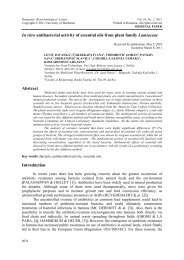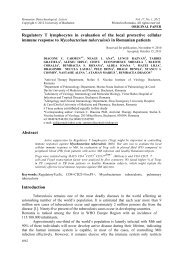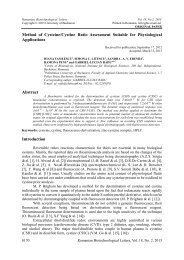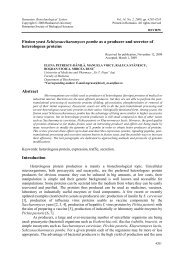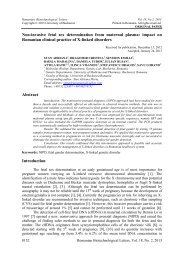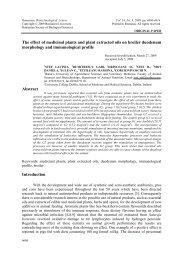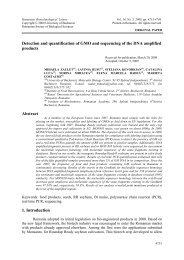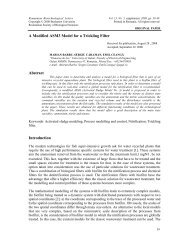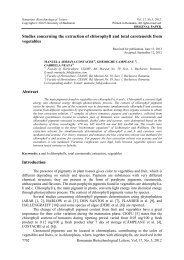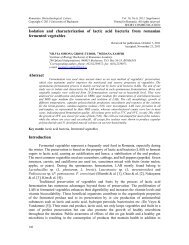The use of RAPD and ISSR markers for genetic ... - Rombio.eu
The use of RAPD and ISSR markers for genetic ... - Rombio.eu
The use of RAPD and ISSR markers for genetic ... - Rombio.eu
You also want an ePaper? Increase the reach of your titles
YUMPU automatically turns print PDFs into web optimized ePapers that Google loves.
Romanian Biotechnological Letters Vol.17, No.4, 2012<br />
Copyright © 2012 University <strong>of</strong> Bucharest<br />
Printed in Romania. All rights reserved<br />
ORIGINAL PAPER<br />
<strong>The</strong> <strong>use</strong> <strong>of</strong> <strong>RAPD</strong> <strong>and</strong> <strong>ISSR</strong> <strong>markers</strong> <strong>for</strong> <strong>genetic</strong> diversity among some<br />
barley cultivars<br />
Abstract<br />
Received <strong>for</strong> publication, February 12, 2012<br />
Accepted, May 1, 2012<br />
VELICEVICI GIANCARLA 1* , MADOŞĂ EMILIAN 1 , ŞUMĂLAN RADU 1 ,<br />
CIULCA SORIN 1 , POPESCU SORINA 1 , PETOLESCU CERASELA 1 ,<br />
1 Banat , s University <strong>of</strong> Agricultural Sciences <strong>and</strong> Veterynary Medicine, Faculty <strong>of</strong> Horticulture<br />
<strong>and</strong> Forestry, Aradului Street 119, 300645 Timisoara, Romania<br />
* Corresponding author: giancarlavely2000@yahoo.com<br />
<strong>The</strong> success <strong>of</strong> a breeding program depended on the <strong>genetic</strong> variability available into the<br />
germoplasm <strong>of</strong> the crop. <strong>The</strong> objective<strong>of</strong> the present study were to assess molecular variation among<br />
different Romanian <strong>and</strong> <strong>for</strong>eign barley cultivars, <strong>and</strong> to determine the level <strong>of</strong> <strong>genetic</strong> similarity<br />
among them. <strong>The</strong> results demonstrated that <strong>RAPD</strong> analysis are <strong>use</strong>ful <strong>for</strong> evaluation <strong>of</strong> <strong>genetic</strong><br />
diversity between different barley cultivars, considering the fact that the average polymorphic rate was<br />
91,17 %, <strong>and</strong> 7,5 polimorphyc b<strong>and</strong>s /primer. Total polymorphism generated by a certain primer<br />
(PIC), presented values between 0,147 to P27 <strong>and</strong> 0,438 to P-1. <strong>The</strong> discrimination index (PI),<br />
registered values among 0,787 <strong>for</strong> the primer E6 <strong>and</strong> 2,626 <strong>for</strong> P-1 primer, which had the highest<br />
capacity to generate polymorphic b<strong>and</strong>s to barley cultivars studied. Among the tested <strong>ISSR</strong> primers,<br />
only 5 amplified polymorphic <strong>ISSR</strong> loci with an average number <strong>of</strong> 9.2 b<strong>and</strong>s/primer <strong>and</strong> the mean<br />
percentage <strong>of</strong> <strong>ISSR</strong> polymorphism was 89,13%. <strong>The</strong> total <strong>of</strong> polymorphism (PIC) presented values<br />
contained among 0,245 to 811 <strong>and</strong> 0,391 to 810. <strong>The</strong> (PI) registered values among 1,562 <strong>for</strong> primer<br />
810 <strong>and</strong> 2,803 <strong>for</strong> HB15 primer. <strong>RAPD</strong>-PCR <strong>and</strong> <strong>ISSR</strong> analysis through two categories <strong>of</strong> <strong>markers</strong>,<br />
attested the existence <strong>of</strong> a high <strong>genetic</strong> variability among studied cultivars, which can be efficiently<br />
exploited in the breeding programs <strong>of</strong> barley. <strong>The</strong> <strong>use</strong> <strong>of</strong> cultivars from various clusters <strong>and</strong> sub<br />
clusters <strong>of</strong>fer the possibility <strong>of</strong> obtaining an appropriate <strong>genetic</strong> variability in hybrid population.<br />
Key words: <strong>RAPD</strong>s <strong>and</strong> <strong>ISSR</strong>s, Bulked analyses, barley, <strong>genetic</strong> diversity,<br />
Introduction<br />
Barley (Hord<strong>eu</strong>m vulgare L.) was one <strong>of</strong> the most important crop species in the World<br />
<strong>and</strong> had been subject to considerable <strong>genetic</strong> studies. It was a diploid (2n-2x-14), largely selffertilizing<br />
species with a large genome [3].<br />
<strong>The</strong> identification <strong>of</strong> varieties <strong>of</strong> crop plants had become increasingly important to the<br />
documentation <strong>of</strong> <strong>genetic</strong> resources <strong>and</strong> to the protection <strong>of</strong> the breeders’ interests. To the<br />
malting <strong>and</strong> brewing industries, that was especially important beca<strong>use</strong> different varieties <strong>of</strong><br />
barley (Hord<strong>eu</strong>m vulgare L. ssp. vulgare) had widely different qualities <strong>and</strong> <strong>use</strong><br />
characteristics. Farmers needed positive identification <strong>for</strong> the protection <strong>of</strong> their proprietary<br />
rights on varieties. <strong>The</strong> grower needed assurance that the seed lot was <strong>of</strong> the variety he<br />
intended to <strong>use</strong>. Processors might be assured <strong>of</strong> varietal identity <strong>and</strong> that it was free from<br />
mixtures. Examination <strong>of</strong> grain morphological characteristics was the st<strong>and</strong>ard method <strong>of</strong><br />
identifying barley cultivars, but not all <strong>of</strong> them could be distinguished on that basis. Several<br />
biochemical techniques had been <strong>use</strong>d to complement morphological examination <strong>of</strong> barley<br />
cultivars, <strong>and</strong> most <strong>of</strong> them rely on variations among isoenzymes [16] <strong>and</strong> seed storage<br />
proteins [5]. Nevertheless, characterization with those kinds <strong>of</strong> <strong>markers</strong> was not very efficient<br />
<strong>for</strong> barley varieties due to the low levels <strong>of</strong> allelic variation in many isoenzymatic loci, the<br />
Romanian Biotechnological Letters, Vol. 17, No. 4, 2012 7493
VELICEVICI GIANCARLA, MADOŞĂ EMILIAN, ŞUMĂLAN RADU,<br />
CIULCA SORIN,POPESCU SORINA, PETOLESCU CERASELA<br />
high degree <strong>of</strong> <strong>genetic</strong> relationship among the different varieties, <strong>and</strong> the high degree <strong>of</strong><br />
polymorphism within barley varieties.<br />
Molecular <strong>markers</strong> had been proved to be valuable tools in the characterization <strong>and</strong><br />
evaluation <strong>of</strong> <strong>genetic</strong> diversity within <strong>and</strong> between species <strong>and</strong> populations. <strong>The</strong> advent <strong>of</strong> the<br />
polymerase chain reaction (PCR) favored the development <strong>of</strong> different molecular techniques<br />
such as r<strong>and</strong>om amplified <strong>of</strong> polymorphic DNA (<strong>RAPD</strong>) [1,31], simple sequence repeats<br />
(SSR or microsatellite) [17], the sequence-tagged sites (STS), r<strong>and</strong>om amplified microsatellite<br />
polymorphism (RAMP), <strong>and</strong> inter-simple sequence repeat polymorphic DNA (<strong>ISSR</strong>) [24 ].<br />
Those molecular <strong>markers</strong> had been <strong>use</strong>d in barley <strong>for</strong> detecting <strong>genetic</strong> diversity (Ciulca,<br />
2010), genotype identification, <strong>and</strong> <strong>genetic</strong> mapping [10, 17, 27].<br />
Genetic analysis with <strong>RAPD</strong> <strong>markers</strong> is relatively easy, fast <strong>and</strong> efficient, there<strong>for</strong>e it<br />
has been extensively <strong>use</strong>d to determine <strong>genetic</strong> diversity among barley varieties <strong>and</strong> to<br />
identify the best quality ones <strong>for</strong> malting [9, 10, 27]. Nevertheless, there are few studies about<br />
<strong>genetic</strong> characterization <strong>of</strong> hull-less barley [32]. Determination <strong>of</strong> <strong>genetic</strong> variability among<br />
genotypes is <strong>use</strong>ful <strong>for</strong> both practical applications in a breeding program <strong>and</strong> cultivar<br />
protection. A variety <strong>of</strong> approaches, from morphological data to molecular <strong>markers</strong> including<br />
<strong>RAPD</strong> [4, 13, 33], AFLP [1], SSR [14, 15 ] <strong>and</strong> <strong>ISSR</strong> [13, 22 ] <strong>markers</strong> have been applied <strong>for</strong><br />
assessment <strong>of</strong> <strong>genetic</strong> variability among genotypes.<br />
<strong>ISSR</strong> <strong>markers</strong>, which involve PCR amplifications <strong>of</strong> DNA using a primer, composed<br />
<strong>of</strong> a microsatellite sequence anchored at 3′ or 5′ end by 2–4 arbitrary, could be <strong>use</strong>d to assess<br />
<strong>genetic</strong> diversity [28]. <strong>ISSR</strong>s had been <strong>use</strong>d <strong>for</strong> cultivar identification <strong>for</strong> potatoes [23], wheat<br />
[21], bean [18], <strong>and</strong> barley [10, 26]. <strong>The</strong> underst<strong>and</strong>ing <strong>and</strong> knowledge <strong>of</strong> <strong>genetic</strong> variation<br />
<strong>and</strong> <strong>genetic</strong> similarities present within individuals or populations are <strong>use</strong>ful <strong>for</strong> the efficient<br />
<strong>use</strong> <strong>of</strong> <strong>genetic</strong> resources in a breeding program. <strong>The</strong> breeder can <strong>use</strong> the <strong>genetic</strong> similarity<br />
in<strong>for</strong>mation to complement phenotypic in<strong>for</strong>mation in the development <strong>of</strong> breeding<br />
populations [11].<br />
In this study, we evaluated <strong>genetic</strong> diversity using <strong>RAPD</strong> <strong>and</strong> <strong>ISSR</strong> <strong>markers</strong>, in order<br />
to establish a base line to assist future conservation <strong>and</strong> breeding programs <strong>of</strong> this species.<br />
Also we aimed to report the <strong>use</strong>fulness <strong>of</strong> <strong>RAPD</strong> <strong>and</strong> <strong>ISSR</strong> <strong>for</strong> the assessment <strong>of</strong> <strong>genetic</strong><br />
diversity.<br />
Materials <strong>and</strong> methods<br />
Plant material. Ten leaves from each <strong>of</strong> the 19 cultivars were collected separately <strong>and</strong> stored<br />
immediately at-80 o <strong>for</strong> DNA extraction. <strong>The</strong> cultivars numbers <strong>and</strong> country <strong>of</strong> origin are listed<br />
in (Tab.1).<br />
Table 1. Studied barley cultivars <strong>and</strong> their geographical origins<br />
code. Genotypes Locatian code. Genotypes Location<br />
1 Orizont Romania 11 Plaisant Hungary<br />
2 Dana Romania 12 Tas Hungary<br />
3 Precoce Romania 13 Secura Austria<br />
4 Adi Romania 14 Dina Germany<br />
5 Mădălin Romania 15 DH19/1 Romania<br />
6 Andrei Romania 16 DH 254/10 Romania<br />
7 Regal Romania 17 DH 260/18 Romania<br />
8 Compact Romania 18 DH 260/12 Romania<br />
9 Gerbel Germany 19 DH 261/22 Romania<br />
10 Lyric France<br />
7494 Romanian Biotechnological Letters, Vol. 17, No. 4, 2012
<strong>The</strong> <strong>use</strong> <strong>of</strong> <strong>RAPD</strong> <strong>and</strong> <strong>ISSR</strong> <strong>markers</strong> <strong>for</strong> <strong>genetic</strong> diversity among some barley cultivars<br />
DNA extraction Total genomic DNA from fresh leaves was extracted using cetyltrimethyl<br />
ammonium bromide (CTAB protocol). DNA concentration was determined by both<br />
spectrophotometry at 260 nm <strong>and</strong> by 2% agarose gel electrophoresis.<br />
Primers<br />
A set <strong>of</strong> 13 <strong>RAPD</strong> primers was screened using ten DNA samples from each cultivar<br />
<strong>and</strong> on the basis <strong>of</strong> that preliminary data, 9 polymorphic <strong>RAPD</strong> were chosen, <strong>and</strong> 7 primers<br />
were tested <strong>for</strong> <strong>ISSR</strong>, <strong>and</strong> 5 were chosen.<br />
In table 2 were presented the sequences <strong>of</strong> the <strong>RAPD</strong> <strong>and</strong> <strong>ISSR</strong> primers <strong>use</strong>d <strong>for</strong> detection <strong>of</strong><br />
the <strong>genetic</strong> polymorphism.<br />
Table 2. Primers sequences <strong>use</strong>d <strong>for</strong> PCR analysis<br />
Primers<br />
<strong>RAPD</strong> code<br />
Nucleotide<br />
sequences<br />
Primers<br />
<strong>ISSR</strong><br />
code<br />
Nucleotide<br />
sequences<br />
(5’-3’)<br />
(5’-3’)<br />
P-1 ACACAGAGGG HB-12 (CAC) 3 GC<br />
P-16 TCGGCGGTTC HB-14 (CTC) 3 GC<br />
P-17 CTGCATCGTG HB-15 (GTG) 3 GC<br />
P-27 CCGTGCAGTA 810 (GA) 8 T<br />
OPA-05 AGG GGT CTT G 811 (GA) 8 C<br />
OPA-11 CAA TCG CCG T<br />
OPG-02 GGCACTGAGG<br />
E-6 AAGACCCCTC<br />
A-16 AGCCAGCGAA<br />
<strong>RAPD</strong>- PCR reaction<br />
<strong>The</strong> amplifications were carried out in a 25 μl PCR buffer containing: GoTaq® Green Master<br />
Mix ready-to-<strong>use</strong> solutions (GoTaq® DNA Polymerase, dNTP, MgCl2, <strong>and</strong> reactions buffers<br />
at optimal concentrations <strong>for</strong> efficient amplification <strong>of</strong> DNA templates), <strong>RAPD</strong> primers, DNA<br />
template <strong>and</strong> Nuclease-Free Water. GoTaq® Green Master Mix contained two dyes (blue <strong>and</strong><br />
yellow) that allow monitoring <strong>of</strong> progress during eletrophoresis. DNA amplification was<br />
carried out using a <strong>The</strong>rmalcycler by Corbett <strong>and</strong> reactions were submitted to the following<br />
PCR program: preliminary DNA denaturation step at 94°C <strong>for</strong> 4 min, followed by 35 cycles at<br />
94°C<strong>for</strong> 1 min., 35°C <strong>for</strong> 1 min. <strong>and</strong> 72°C <strong>for</strong> 2 min. A final extension <strong>for</strong> 4 min at 72°C was<br />
included. <strong>The</strong> <strong>RAPD</strong> products were separated by 2% agarose gels electrophoresis (3V cm-1),<br />
which run with 1xTAE buffer. <strong>The</strong> PCR marker (1000-50bp) was also run on each gel as a<br />
molecular weight st<strong>and</strong>ard. Photo documentation was per<strong>for</strong>med under UV light using a<br />
photo imaging system.<br />
<strong>ISSR</strong>-PCR reaction<br />
<strong>The</strong> amplifications were carried out in a 25 μl PCR buffer containing: Go Taq® Green Master<br />
Mix ready-to-<strong>use</strong> solutions (GoTaq® DNA Polymerase, dNTP, MgCl2, <strong>and</strong> reactions buffers<br />
at optimal concentrations <strong>for</strong> efficient amplification <strong>of</strong> ADN templates), <strong>ISSR</strong> primers, DNA<br />
template <strong>and</strong> Nuclease-Free Water. GoTaq® Green Master Mix contains two dyes (blue <strong>and</strong><br />
yellow) that allow monitoring <strong>of</strong> progress during electrophoresis. DNA amplification was<br />
carried out using a <strong>The</strong>rmalcycler by Corbett <strong>and</strong> reactions were submitted to the following<br />
PCR program: preliminary DNA denaturation step at 94°C <strong>for</strong> 5 min, followed by 40 cycles<br />
at 94°C <strong>for</strong> 30s, a primer annealing step at 52°C <strong>for</strong> 45 s. <strong>and</strong> an extension at 72°C <strong>for</strong> 2 min,<br />
then a final extension was carried out at 72°C <strong>for</strong> 6 min. <strong>The</strong> <strong>ISSR</strong> products were separated by<br />
2% agarose gels electrophoresis (3V cm-1), which run with 1xTAE buffer. <strong>The</strong> st<strong>and</strong>ard<br />
marker <strong>use</strong>d as marker <strong>of</strong> ADN quantity was PCR marker. Photo documentation was<br />
per<strong>for</strong>med under UV light using a photo imaging system.<br />
Romanian Biotechnological Letters, Vol. 17, No. 4, 2012 7495
VELICEVICI GIANCARLA, MADOŞĂ EMILIAN, ŞUMĂLAN RADU,<br />
CIULCA SORIN,POPESCU SORINA, PETOLESCU CERASELA<br />
Data analysis<br />
To make calculs after the analysis made through different primers, were selected as being<br />
present (1) only the clear b<strong>and</strong>s, while the b<strong>and</strong>s with a very reduced resolution were marked<br />
as absent (0). Further, the respectively b<strong>and</strong>s were introduced in a binar matrix. Concerning<br />
the potential characterisation <strong>of</strong> different systems <strong>of</strong> molecular <strong>markers</strong> to evaluate the<br />
interpopulational variability to the studied genotypes, were calculated different parameters:<br />
-total polymorphism generated by a certain primer (PIC) which indicated its discriminatory<br />
n−1<br />
2<br />
power: PIC = −∑Pij<br />
−∑<br />
∑<br />
n<br />
1 2P<br />
P ;<br />
i= 1 i=<br />
1 j=<br />
i+<br />
1<br />
Pi- allele’ frequencyi; Pj- allele’ frequency; Pij- allele’ frequency i <strong>for</strong> locus j;<br />
n- total number <strong>of</strong> loci.<br />
-discrimination index (Pi), which attested the efficiency <strong>of</strong> a certain primer in polymorphism<br />
detection [8].<br />
PI = ∑ PIC .<br />
Genetic similarity among genotypes studied calculated through coefficient Jaccard, which was<br />
recommended to be <strong>use</strong>d <strong>for</strong> dominant <strong>markers</strong> <strong>ISSR</strong>, <strong>RAPD</strong>, taking in view that the absence<br />
<strong>of</strong> a b<strong>and</strong>s was associated to a homozygous loci. JC= a / (a+b+c), where a, b, c, represented<br />
the commons <strong>and</strong> un-commons <strong>of</strong> those genotypes [29 ].<br />
On base <strong>of</strong> <strong>genetic</strong> similarity matrix among genotypes, it was made the dendrogram using the<br />
method <strong>of</strong> clusters average. Two separate dendrograms <strong>for</strong> <strong>ISSR</strong> <strong>and</strong> <strong>RAPD</strong> data were<br />
generated. <strong>The</strong> distance matrices obtained in <strong>RAPD</strong> <strong>and</strong> <strong>ISSR</strong> analyses were compared using<br />
correlation analysis.<br />
Results <strong>and</strong> Discussions<br />
<strong>RAPD</strong> <strong>and</strong> <strong>ISSR</strong> analysis<br />
Studies conducted on different primers with arbitrary sequence have established that to<br />
produce detectable levels <strong>of</strong> amplification, the minimum length <strong>of</strong> primers might be <strong>of</strong> nine<br />
bases, while in case <strong>of</strong> decamer primers guanine cytosine should be at least 40% [30]. Each<br />
primer, generally determines the amplification <strong>of</strong> sequences from several genome loci this<br />
being the reason why this technique is an effective means <strong>of</strong> assessing DNA polymorphism in<br />
different genotypes [19 ].<br />
Table 3. Polymorphism rate <strong>of</strong> barley cultivars through <strong>RAPD</strong> primers<br />
No. Primer code No. b<strong>and</strong>s Polimor- Range <strong>of</strong> PIC PI<br />
Total No <strong>of</strong> Polymorphic phism (%) fragment x ± s<br />
x<br />
fragments fragments<br />
size (pb)<br />
1 P-1 7 6 85.71 300-1250 0,438+0,074 2,626<br />
2 P-16 9 6 66.67 120-1000 0,235+0,069 1,407<br />
3 P-17 9 9 100 100-1000 0,228+0,058 2,050<br />
4 P-27 11 10 90.91 75-1250 0,147+0,043 2,526<br />
5 OPA-05 8 8 100 150-1200 0,298+0,046 2,382<br />
6 OPA-11 7 7 100 200-1000 0,334+0,053 2,338<br />
7 OPG-02 7 6 85.71 200-1000 0,192+0,065 1,341<br />
8 E-6 3 3 100 1400-2000 0,262+0,121 0,787<br />
9 A-16 7 7 100 1000-3500 0,258+0,062 1,806<br />
n<br />
2<br />
i<br />
2<br />
j<br />
7496 Romanian Biotechnological Letters, Vol. 17, No. 4, 2012
<strong>The</strong> <strong>use</strong> <strong>of</strong> <strong>RAPD</strong> <strong>and</strong> <strong>ISSR</strong> <strong>markers</strong> <strong>for</strong> <strong>genetic</strong> diversity among some barley cultivars<br />
Among the tested <strong>RAPD</strong> primers, only nine generated polymorphic b<strong>and</strong>s, resulting<br />
a polymorphic rate with values between 66,67% in case <strong>of</strong> P-16 <strong>and</strong> 100% <strong>for</strong><br />
oligonucleotides OPA05, OPA11, P-17, A16, E6, (Table.3). <strong>The</strong> average number <strong>of</strong><br />
polymorphic b<strong>and</strong>s per primer was 7,5 with an average rate <strong>of</strong> polymorphism being 91,17%.<br />
Total polymorphism generated by a certain primer (PIC), presented values between<br />
0,147 to P27 <strong>and</strong> 0,438 to P-1. <strong>The</strong> discrimination index (PI), registered values among 0,787<br />
<strong>for</strong> the primer E6 <strong>and</strong> 2,626 <strong>for</strong> P-1 primer, which had the highest capacity to generate<br />
polymorphic b<strong>and</strong>s to barley genotypes studied.<br />
<strong>The</strong> dendrogram <strong>of</strong> <strong>genetic</strong> distances among all tested genotypes based on b<strong>and</strong><br />
polymorphism generated by <strong>RAPD</strong> –PCR after using the primers is shown in fig.1. <strong>The</strong><br />
dendrogram separated all cultivars in five clusters. First clusters divided in two sub clusters;<br />
first sub cluster included Romanian cultivar Orizont together with <strong>for</strong>eign Dina <strong>and</strong> Secura<br />
cultivars <strong>and</strong> second subcluster is composed <strong>of</strong> Adi, Madalin, Regal, Andrei, Lyric, Tas<br />
cultivars, showing an average <strong>genetic</strong> diversity <strong>of</strong> approximately 8%.<br />
<strong>The</strong> second cluster consist <strong>of</strong> cultivars Precoce, Plaisant <strong>and</strong> double haploid lines DH<br />
19/1, DH260/18, DH254/10, DH260/12 recording a <strong>genetic</strong> similarity <strong>of</strong> 60% between them,<br />
<strong>and</strong> an average diversity <strong>of</strong> approximately 13% toward the first group. Genotypes Dana <strong>and</strong><br />
Gerbel, similar between them in proportion <strong>of</strong> 54% made the third cluster. <strong>The</strong> <strong>for</strong>th cluster<br />
contained only genotype Compact, it was similar in proportion <strong>of</strong> 63% with cultivars Andrei ,<br />
Regal <strong>and</strong> presented the highest <strong>genetic</strong> difference (62%) face to double haploid line DH261/22.<br />
Line DH261/22 contained the fifth cluster, manifesting the highest diversity face to cultivars<br />
Madalin (63,64%), Compact (61,9%) <strong>and</strong> (57,2%) Regal <strong>and</strong> Andrei.<br />
In consequence the usage <strong>of</strong> some genitors from different groups <strong>and</strong> subgroups presented had<br />
<strong>of</strong>fered the possibility to obtain a <strong>genetic</strong> variability corresponding in hybrid populations.<br />
According to data presented in table 4 it observed the existence <strong>of</strong> some correlations<br />
statistically assured among the majority <strong>of</strong> primers studied which attested them as <strong>use</strong>ful with<br />
the same efficiency <strong>for</strong> polymorphism identification <strong>and</strong> <strong>genetic</strong> diversity establishment to<br />
barley. <strong>The</strong> strongest correlation existed among oligonucleotides OPA 05 <strong>and</strong> P27, which<br />
had capacities very nearby to polymorphism detection at barley genotypes analyzed.<br />
Orizont<br />
Secura<br />
Dina<br />
Adi<br />
Madalin<br />
Regal<br />
Andrei<br />
Lyric<br />
Tas<br />
Precoce<br />
Plaisant<br />
DH19-1<br />
DH260-18<br />
DH254-10<br />
DH260-12<br />
Dana<br />
Gerbel<br />
Compact<br />
DH261-22<br />
0.50<br />
0.60<br />
0.70<br />
Similarity coefficient<br />
0.80<br />
0.90<br />
1.00<br />
Fig 1. UPGMA clustering <strong>of</strong> barley cultivars using the <strong>RAPD</strong> primers<br />
Romanian Biotechnological Letters, Vol. 17, No. 4, 2012 7497
VELICEVICI GIANCARLA, MADOŞĂ EMILIAN, ŞUMĂLAN RADU,<br />
CIULCA SORIN,POPESCU SORINA, PETOLESCU CERASELA<br />
Table 4. <strong>The</strong> coefficient values <strong>of</strong> correlation among <strong>RAPD</strong> primers under the <strong>genetic</strong> similarity aspect <strong>of</strong> the<br />
barley cultivars studied<br />
Primers P-1 P-16 P-17 P-27 OPA5 OPA11 OPG2 E-6 A-16<br />
P-1 - 0,072 0,178*** 0,334*** 0,246*** 0,205*** 0,170** 0,027 0,182***<br />
P-16 - 0,323*** 0,168** 0,129* 0,317*** 0,101 0,149** 0,090<br />
P-17 - 0,383*** 0,270*** 0,170** 0,355*** 0,392*** 0,192***<br />
P-27 - 0,536*** 0,267*** 0,338*** 0,177*** 0,210***<br />
OPA5 - 0,107* 0,251*** 0,137* 0,269***<br />
OPA11 - 0,152** 0,137* 0,079<br />
OPG2 - 0,387*** 0,183***<br />
E-6 - 0,171**<br />
A-16 -<br />
r 5% = 0,105; r 1% = 0,138; r 0,1% = 0,176;<br />
<strong>The</strong> six alleles common identified <strong>for</strong> to all the 19 th genotypes studied (Table 5) could<br />
be considered specific <strong>markers</strong> <strong>RAPD</strong> <strong>for</strong> the barley.<br />
Table 5. Specific <strong>RAPD</strong> alleles common <strong>for</strong> all the barley cultivars studied<br />
No.<br />
Specific alleles<br />
1 OPG2-400pb<br />
2. P1-400pb<br />
3. P27-600pb<br />
4. P16-530pb<br />
5. P16-650pb<br />
6. P16-850pb<br />
Inter simple sequence repeat (<strong>ISSR</strong>)-PCR is a technique, which involves the <strong>use</strong> <strong>of</strong><br />
microsatellite sequences as primers in a polymerase chain reaction to generate multilocus<br />
<strong>markers</strong>. It is a simple <strong>and</strong> quick method that combines most <strong>of</strong> the advantages <strong>of</strong><br />
microsatellites (SSRs) <strong>and</strong> amplified fragment length polymorphism (AFLP) to the<br />
universality <strong>of</strong> r<strong>and</strong>om amplified polymorphic DNA (<strong>RAPD</strong>). <strong>ISSR</strong> <strong>markers</strong> are highly<br />
polymorphic <strong>and</strong> are <strong>use</strong>ful in studies on <strong>genetic</strong> diversity, phylogeny, gene tagging, genome<br />
mapping <strong>and</strong> evolutionary biology [25] .<strong>ISSR</strong> <strong>markers</strong> have been <strong>use</strong>d <strong>for</strong> studies <strong>of</strong><br />
hybridization <strong>and</strong> hybrid speciation [2], population <strong>and</strong> conservation <strong>genetic</strong>s [7], <strong>and</strong><br />
systematic investigations in natural populations [20].<br />
Among the tested <strong>ISSR</strong> primers, only five amplified polymorphic <strong>ISSR</strong> loci,<br />
resulting a rate <strong>of</strong> polymorphism with values between 57,14% in case <strong>of</strong> primer 810 <strong>and</strong><br />
100% <strong>for</strong> the first 811, HB12, HB15 (Table.6). <strong>The</strong> amplified fragments had size among 150<br />
<strong>and</strong> 600 pb <strong>for</strong> HB-15 primer, while 810 primer registered the highest amplitude <strong>of</strong> amplified<br />
fragments size (950- 5100 pb). <strong>The</strong> average number <strong>of</strong> polymorphic b<strong>and</strong>s per primer was 9.2<br />
with an average rate <strong>of</strong> polymorphism being 89,13 %.<br />
<strong>The</strong> total <strong>of</strong> polymorphism generated by a certain primer (PIC) presented values<br />
among 0,245 to 811 <strong>and</strong> 0,391 to 810. <strong>The</strong> discrimination index (PI) registered values among<br />
1,562 <strong>for</strong> primer 810 <strong>and</strong> 2,803 <strong>for</strong> HB15 primer.<br />
Table 6. Polymorphism rate <strong>of</strong> barley cultivars through <strong>ISSR</strong> primers<br />
No.. Primers Nucleotide No. b<strong>and</strong>s Polymorphis Range <strong>of</strong> PIC PI<br />
sequence Total No <strong>of</strong> Polymorphic m (%) size b<strong>and</strong>s x ± s<br />
x<br />
(5’-3’) fragments fragments<br />
(pb)<br />
1 HB-12 (CAC)3GC 9 9 100 175-850 0,309+0,044 2,781<br />
2 HB-14 (CTC)3GC 12 10 83.33 200-1400 0,264+0,053 1,806<br />
3 HB-15 (GTG)3GC 9 9 100 150-600 0,311+0,059 2,803<br />
4 810 (GA) 8 T 7 4 57.14 950-5100 0,391+0,111 1,562<br />
5 811 (GA) 8 C 9 9 100 950-2000 0,245+0,053 2,205<br />
7498 Romanian Biotechnological Letters, Vol. 17, No. 4, 2012
<strong>The</strong> <strong>use</strong> <strong>of</strong> <strong>RAPD</strong> <strong>and</strong> <strong>ISSR</strong> <strong>markers</strong> <strong>for</strong> <strong>genetic</strong> diversity among some barley cultivars<br />
According the <strong>ISSR</strong> data, a dendrogram was developed <strong>for</strong> 19 cultivars <strong>and</strong> indicates<br />
four main clusters; the first cluster divided into two sub clusters, first sub cluster included<br />
Romanian cultivars Orizont <strong>and</strong> Dana presenting a <strong>genetic</strong> similarity <strong>of</strong> 75% <strong>for</strong> <strong>ISSR</strong> alleles<br />
<strong>and</strong> second sub cluster <strong>for</strong>med a separate sub cluster with Precoce cultivar, that presenting a<br />
difference <strong>of</strong> 10% face to the cultivars from the first sub cluster. Second sub cluster was further<br />
divided in two sub clusters. Among the two sub clusters, first sub cluster <strong>for</strong>med a separate sub<br />
cluster with Romanian cultivars Adi, Regal, Andrei DH 254/10, DH260/18, Madalin, <strong>and</strong><br />
second sub cluster included <strong>for</strong>eign cultivars Gerbel, Lyric, Tas, Plaisant, Dina, <strong>and</strong> Romanian<br />
duble haploide lines DH19/1.Cultivar Compact made second cluster manifesting an average<br />
<strong>genetic</strong> similarity <strong>of</strong> approximate 46% with cultivars Orizont <strong>and</strong> 55% with Regal <strong>and</strong> Andrei.<br />
Cultivar Secura presented a <strong>genetic</strong> similarity <strong>of</strong> 52% with Orizont, making the third cluster.<br />
Double haploid lines DH260/12, DH261/22 made a fourth cluster, presenting a <strong>genetic</strong><br />
difference <strong>of</strong> approximate 53% face to the genotypes from the first cluster; the highest <strong>genetic</strong><br />
difference registering face to cultivars Compact (75%), Regal <strong>and</strong> Secura.<br />
<strong>ISSR</strong> analysis through the 5 primers, attested the existence <strong>of</strong> a high <strong>genetic</strong> variability<br />
among cultivars involved in this study, which could be efficiently exploited in breeding<br />
programs <strong>of</strong> barley.<br />
<strong>The</strong> results presented in table 7 attested the existence <strong>of</strong> some significant correlations<br />
among <strong>ISSR</strong> primers, with exception 811 primer. <strong>The</strong> highest correlation obtained among<br />
HB15 <strong>and</strong> HB14 primers which had capacities very nearby <strong>of</strong> polymorphism detection to<br />
barley genotypes analyzed.<br />
Table 7. <strong>The</strong> coefficient values <strong>of</strong> correlation among <strong>ISSR</strong> primers under <strong>genetic</strong> similarity aspect <strong>of</strong> barley<br />
genotypes studied<br />
Primers HB-12 HB-14 HB-15 810 811<br />
HB-12 - 0,338*** 0,331*** 0,333*** 0,192***<br />
HB-14 - 0,401*** 0,219*** 0,383***<br />
HB-15 - 0,258*** 0,063<br />
810 - 0,179***<br />
811 -<br />
r 5% = 0,105; r 1% = 0,138; r 0,1% = 0,176;<br />
Orizont<br />
Dana<br />
Precoce<br />
Adi<br />
Regal<br />
Andrei<br />
DH254-10<br />
DH260-18<br />
Madalin<br />
Gerbel<br />
Lyric<br />
Tas<br />
Plaisant<br />
Dina<br />
DH19-1<br />
Compact<br />
Secura<br />
DH260-12<br />
DH261-22<br />
0.50<br />
0.60<br />
0.70<br />
Similarity coefficient<br />
0.80<br />
0.90<br />
1.00<br />
Fig. 2. UPGMA clustering <strong>of</strong> barley cultivars using the <strong>ISSR</strong> primers<br />
Romanian Biotechnological Letters, Vol. 17, No. 4, 2012 7499
VELICEVICI GIANCARLA, MADOŞĂ EMILIAN, ŞUMĂLAN RADU,<br />
CIULCA SORIN,POPESCU SORINA, PETOLESCU CERASELA<br />
At the same time were identified 5 alleles presented to all the 19 th genotypes studied<br />
(Table.8). Those alleles could be considered specific <strong>markers</strong> <strong>for</strong> the barley.<br />
Table 8. Specific alleles common <strong>for</strong> all the barley genotypes studied<br />
No. Specific alleles<br />
1 HB14-1000pb<br />
2. HB14-450pb<br />
3. 810-950pb<br />
4. 810-1100pb<br />
5. 810-1300pb<br />
<strong>The</strong> analysis results made through two categories <strong>of</strong> primers had emphasized the fact that to<br />
some cultivar studied it were identified unique b<strong>and</strong>s (Table.9). Those b<strong>and</strong>s could be <strong>use</strong>d as<br />
potential DNA <strong>markers</strong> to identify the barley genotypes.<br />
Table 9. Specific alleles <strong>for</strong> certain barley genotypes<br />
No. Genotype Specific alleles<br />
1. Lyric HB15-150pb<br />
2. Secura 811-1000pb<br />
3. Dina 811-1500pb<br />
4. Compact HB14- 200pb<br />
5 Precoce OPA-05-450pb<br />
Molecular characterization revealed 91,17% polymorphism <strong>of</strong> <strong>RAPD</strong> <strong>markers</strong> <strong>and</strong><br />
89.13% polymorphism <strong>of</strong> <strong>ISSR</strong> <strong>markers</strong> among cultivars. <strong>The</strong> difference is perhaps explained<br />
by the difference in the DNA segments targeted by the two methods. <strong>The</strong> similar results were<br />
observed by [10,13, 26]. Markers <strong>ISSR</strong> proved more efficient than <strong>RAPD</strong> <strong>markers</strong> thanks to<br />
the higher number <strong>of</strong> b<strong>and</strong>s/primer (9,2) <strong>and</strong> <strong>of</strong> efficiency index (8,2). Fern<strong>and</strong>ez et al. (2002)<br />
have studied 16 barley cultivars <strong>for</strong>m different countries <strong>and</strong> they have found high similarity<br />
index by <strong>ISSR</strong>s than by <strong>RAPD</strong>s. It may be due to highly polymorphic, abundant nature <strong>of</strong> the<br />
microsattelites due to slippage in DNA replication.<br />
<strong>The</strong> variation amplitude about the sizes b<strong>and</strong>s was significant superior in case <strong>of</strong> <strong>ISSR</strong><br />
primers (4950pb), comparative with <strong>RAPD</strong> primers (3425pb). <strong>The</strong> differences found among<br />
the dendrograms generated by <strong>RAPD</strong>s <strong>and</strong> <strong>ISSR</strong>s could be partially explained by the different<br />
number <strong>of</strong> PCR products analyzed (68 <strong>for</strong> <strong>RAPD</strong>s <strong>and</strong> 46 <strong>for</strong> <strong>ISSR</strong>s) rein<strong>for</strong>cing again the<br />
importance <strong>of</strong> the number <strong>of</strong> loci <strong>and</strong> their coverage <strong>of</strong> the overall genome, in obtaining<br />
reliable estimates <strong>of</strong> <strong>genetic</strong> relationships among barley cultivars. Similar results had been<br />
observed by [10] also in barley.<br />
<strong>The</strong> microsatellites or intersimple sequence repeat (<strong>ISSR</strong>) <strong>markers</strong> <strong>and</strong> r<strong>and</strong>omly amplified<br />
polymorphic DNA (<strong>RAPD</strong>) <strong>markers</strong> have proved to be the most polymorphic <strong>markers</strong> in<br />
barley <strong>and</strong> hence are highly <strong>use</strong>ful <strong>markers</strong> <strong>for</strong> various applications in barley [10 ]. <strong>The</strong>se<br />
<strong>markers</strong> can be <strong>use</strong>d <strong>for</strong> selection <strong>of</strong> important agronomic traits which would increase the<br />
efficiency <strong>and</strong> precision <strong>of</strong> breeding. In a previous study [12], some traits were <strong>use</strong>d to<br />
evaluate the agronomical potentiality <strong>of</strong> barely specimens in south Tunisia. It has been noted<br />
that although the importance <strong>of</strong> agronomic parameters, it is necessary to <strong>use</strong> other <strong>markers</strong> to<br />
study diversity <strong>and</strong> select genotypes with high potential.<br />
With that study we could conclude that the bulk analyses <strong>of</strong> <strong>RAPD</strong> <strong>and</strong> <strong>ISSR</strong> <strong>markers</strong><br />
were <strong>use</strong>ful <strong>for</strong> study the <strong>genetic</strong> relationships between barley cultivars, providing the <strong>ISSR</strong><br />
7500 Romanian Biotechnological Letters, Vol. 17, No. 4, 2012
<strong>The</strong> <strong>use</strong> <strong>of</strong> <strong>RAPD</strong> <strong>and</strong> <strong>ISSR</strong> <strong>markers</strong> <strong>for</strong> <strong>genetic</strong> diversity among some barley cultivars<br />
<strong>markers</strong> a powerful tool <strong>for</strong> the generation <strong>of</strong> potential fingerprinting diagnostic <strong>markers</strong> <strong>for</strong><br />
cultivars.<br />
Table 10. Comparative analysis <strong>of</strong> b<strong>and</strong>s characteristics generated by <strong>RAPD</strong> <strong>and</strong> <strong>ISSR</strong> <strong>markers</strong><br />
Conclusions<br />
Parameter <strong>RAPD</strong> <strong>ISSR</strong><br />
Number <strong>of</strong> primers 9 5<br />
Total number <strong>of</strong> b<strong>and</strong>s 68 46<br />
Number b<strong>and</strong>s/primer 7,55 9,2<br />
Number polymorphic b<strong>and</strong>s 62 41<br />
Rate <strong>of</strong> polymorphism 91,17 89,13<br />
B<strong>and</strong>s size 75-3500 150-5100<br />
Efficiency index 6,88 8,2<br />
<strong>The</strong> results demonstrated that <strong>RAPD</strong> <strong>and</strong> <strong>ISSR</strong> analyses are <strong>use</strong>ful <strong>for</strong> evaluation <strong>of</strong><br />
<strong>genetic</strong> diversity between different barley cultivars, considering the fact that the average<br />
polymorphic rate was 91.17 % respectively 89.13% <strong>and</strong> number <strong>of</strong> polymorphic b<strong>and</strong>s /<br />
primer.<br />
<strong>The</strong> <strong>use</strong> <strong>of</strong> cultivars from various clusters <strong>and</strong> sub clusters <strong>of</strong>fers the possibility <strong>of</strong> obtaining<br />
an appropriate <strong>genetic</strong> variability in hybrid populations. <strong>The</strong> strongest correlation existed<br />
among oligonucleotides OPA 05 <strong>and</strong> P27; HB15 <strong>and</strong> HB14 which had capacities very<br />
nearby to polymorphism detection at barley genotypes analyzed. <strong>The</strong> analysis results made<br />
through two categories <strong>of</strong> primers had emphasized the fact that to some cultivar studied it<br />
were identified unique b<strong>and</strong>s. Those b<strong>and</strong>s could be <strong>use</strong>d as potential DNA <strong>markers</strong> to<br />
identify the barley genotypes.<br />
Acknowledgement<br />
This work was published during the project “POSTDOCTORAL SCHOOL OF<br />
AGRICULTURE AND VETERINARY MEDICINE", POSDRU/89/1.5/S/62371, co-financed<br />
by the European Social Fund through the Sectorial Operational Programme <strong>for</strong> the Human<br />
Resources Development 2007-2013.<br />
References<br />
1. AN, W. H., ZHAO, Y., SHANDONG, Y., WANG, Q. LI., ZHUANG, B., GONG, L .<strong>and</strong> LIU, B. Genetic<br />
diversity in annual wild soybean (Glycine soja Sieb. et Zucc.) <strong>and</strong> cultivated soybean (Glycinemax. Merr.)<br />
from different latitudes in China. Pak. J. Bot., 41(5): 2229-2242. DOI 10.1007/s10722-009-9425-3 .2009.<br />
2. ARCHIBALD, J., WOLFE, A. D., <strong>and</strong> JOHNSON, S. Hybridization <strong>and</strong> gene flow between aday- <strong>and</strong><br />
night-flowering species <strong>of</strong> Zaluzianskya (Scrophulariaceae s.s., tribe Manuleeae).Am. J. Botany 91, 1333–<br />
1344, DOI:10.3732/ajb..91.9.1333. 2004.<br />
3. BENNETT, M.D. <strong>and</strong> SMITH, J.B. Nuclear DNA amounts in angiosperms, Philosophical Transactions <strong>of</strong><br />
the Royal Society <strong>of</strong> London B, vol. 274, no. 933, p. 227–274. 1976.<br />
4. BIBI, S., DAHOT, M.U., KHAN I.A., KHATRI ,A. <strong>and</strong> NAQVI, M.H.. Study <strong>of</strong> <strong>genetic</strong> diversity in wheat<br />
(Triticum aestivum L.) using r<strong>and</strong>om amplified polymorphic DNA (<strong>RAPD</strong>) <strong>markers</strong>. Pak. J. Bot., 41(3):<br />
1023-1027, DOI 10.1007/s10722-009-9425-3. 2009.<br />
5. CANCI, P.C., NDUULU, L.M., DILL-MACKY, R., MUEHLBAUER, G.J., RASMUSSON, D.C. <strong>and</strong><br />
SMITH, K.P. Genetic relationship between kernel discoloration <strong>and</strong> grain protein concentration in barley,<br />
Crop Science, vol. 43, no. 5, p. 1671–1679. 2003. DOI: 10.2135/cropsci2003<br />
Romanian Biotechnological Letters, Vol. 17, No. 4, 2012 7501
VELICEVICI GIANCARLA, MADOŞĂ EMILIAN, ŞUMĂLAN RADU,<br />
CIULCA SORIN,POPESCU SORINA, PETOLESCU CERASELA<br />
6. CIULCA, A., CIULCA, S., MADOSA, E., MIHACEA, S., PETOLESCU, C. <strong>RAPD</strong> analysis <strong>of</strong> <strong>genetic</strong><br />
variation among some winter barley cultivars, Romanian Biotechnological Letters ,vol.15, no. 1 suplement ,<br />
p 19-24. DOI: 10.1007/s10482-010-9486-5. 2010<br />
7. CULLEY, T. M., <strong>and</strong> WOLFE, A. D. Population <strong>genetic</strong> structure <strong>of</strong> the cleistogamous plant species Viola<br />
pubescens Aiton (Violaceae), as indicated by allozyme <strong>and</strong> <strong>ISSR</strong> <strong>markers</strong>. Heredity 86, 545–556,<br />
DOI:10.1046/j.1365-2540.2001.00875.x. 2001.<br />
8. DANGI, R.S., LAGU, M.D., CHOUDHARY, L.B., RANJEKAR P.K.<strong>and</strong> GUPTA, V.S. Assessment <strong>of</strong><br />
<strong>genetic</strong> diversity in Trigonella foenum-graecum <strong>and</strong> Trigonella caerulea using <strong>ISSR</strong> <strong>and</strong> <strong>RAPD</strong> <strong>markers</strong>,<br />
BMC Plant Biology; DOI: 10.1186/1471-2229-4-13,2004.<br />
9. DIAZ-PERALES, A., LINACERO, R., VÁZQUEZ, A.M. Analysis <strong>of</strong> <strong>genetic</strong> relationships among 22<br />
European barley varieties base on two PCR <strong>markers</strong>. Euphytica, v.129, p.53-60, DOI:<br />
10.1023/A:1021598227966. 2002.<br />
10. FERNÁNDEZ, M.E., FIGUEIRAS, A.M., <strong>and</strong> BENITO, C. <strong>The</strong> <strong>use</strong> <strong>of</strong> <strong>ISSR</strong> <strong>and</strong> <strong>RAPD</strong> <strong>markers</strong> <strong>for</strong><br />
detecting DNA polymorphism, genotype identification <strong>and</strong> <strong>genetic</strong> diversity among barley cultivars with<br />
known origin, <strong>The</strong>oretical <strong>and</strong> Applied Genetics, vol. 104, no. 5, p. 845–851. DOI: 10.1007/s00122-001-<br />
0848-2. 2002.<br />
11. GREENE S.L., GRITSENKO M. <strong>and</strong> VANDEWARK G. Relating morphological <strong>and</strong> <strong>RAPD</strong> marker<br />
variation to collection site environment in wild populations <strong>of</strong> Red Clover (Trifolium pratenseL.)<br />
Genetic.Resour.CropEvol.51(6):643653, DOI:10.1023/B:GRES.0000024655.48989.ab. 2004.<br />
12. GUASMI, F., TOUIL, L., FÉRES K., MARZOUGUI, N., ELFALLEH, W., AND FERCHICHI, A. Variety<br />
identification <strong>and</strong> <strong>genetic</strong> relationship <strong>of</strong> some South Tunisian barley accessions using agronomic<br />
parameters, Journal <strong>of</strong> Food, Agriculture <strong>and</strong> Environment, vol. 7, no. 2, pp. 522–527, 2009.<br />
13. GUASMI, F., ELFALLEH, W., HANNACHI, H., FÈRES, K., TOUIL, L., MARZOUGUI, N., TRIKI, T.<br />
<strong>and</strong> FERCHICHI, A. <strong>The</strong> Use <strong>of</strong> <strong>ISSR</strong> <strong>and</strong> <strong>RAPD</strong> Markers <strong>for</strong> Genetic Diversity among South Tunisian<br />
Barley, International Scholarly Research Network Agronomy,Volume1,p.1-10, DOI:10.5402/2012/952196.<br />
2012<br />
14. HINA, A., IKBAL, N., HAQ, M.A., SHAH, T.M., ATTA, B.M. <strong>and</strong> HAMEED. A. Detection <strong>of</strong> QTLs <strong>for</strong><br />
blight resistance in cheakpea genotypes with DNA based <strong>markers</strong>. Pak. J. Bot., 40(4): p. 2070-3368, DOI<br />
10.1007/s10722-009-9425-3. 2008.<br />
15. KULEUNG, C., BAENZIGER, P.S. <strong>and</strong> DWEIKAT, I. Transferability <strong>of</strong> SSR <strong>markers</strong> among wheat, rye,<br />
<strong>and</strong> triticale. <strong>The</strong>or. Appl. Genet., 108: 1147-1150. DOI: 10.1007/s00122-003-1532-5, 2004.<br />
16. LAUGESEN S., BAK-JENSEN, K. S., HÄGGLUND, P. Barley peroxidase isozymes. Expression <strong>and</strong> posttranslational<br />
modification in mature seeds as identified by two-dimensional gel electrophoresis <strong>and</strong> mass<br />
spectrometry, International Journal <strong>of</strong> Mass Spectrometry, vol. 268, no. 2-3, p. 244–253, DOI:<br />
10.1016/j.ijms.2007.06.003. 2007.<br />
17. MATUS I.A. <strong>and</strong> HAYES, P.M. Genetic diversity in three groups <strong>of</strong> barley germplasm assessed by simple<br />
sequence repeats, Genome, vol. 45, no. 6, p.1095–1106, DOI:10.1139/g02-071. 2002.<br />
18. MÉTAIS, I., AUBRY, C., HAMON, B., JALOUZOT, R., <strong>and</strong> PELTIER, D. Description <strong>and</strong> analysis <strong>of</strong><br />
<strong>genetic</strong> diversity between commercial bean lines (Phaseolus vulgaris L.), <strong>The</strong>oretical <strong>and</strong> Applied Genetics,<br />
vol. 101, no. 8, p. 1207–1214, DOI 10.1007/s001220051599. 2000.<br />
19. MOLNAR, S.J., JAMES, L.E., KASHA, K.J. Inheritance <strong>and</strong> <strong>RAPD</strong> tagging <strong>of</strong> multiple genes <strong>for</strong><br />
resistance to net blotch in barley , Genome,43 (2),224-231, p.99-111, DOI:10.1139, 2000.<br />
20. 20.MORT, M. E., CRAWFORD, D. J., SANTOS-GUERRA, A., FRANCISCO-ORTEGA, J., ESSELMAN,<br />
E. J., <strong>and</strong> WOLFE, A. D. Relationships among the Macaronesian members <strong>of</strong> Tolpis (Asteraceae:<br />
Lactuceae) based upon analyses <strong>of</strong> inter-simple sequence repeat (<strong>ISSR</strong>) <strong>markers</strong>. Taxon 52, 511–518. 2003.<br />
21. 21.NAGAOKA, T. AND OGIHARA, Y. Applicability <strong>of</strong> inter-simple sequence repeat polymorphisms in<br />
wheat <strong>for</strong> <strong>use</strong> as DNA <strong>markers</strong> in comparison to RFLP <strong>and</strong> <strong>RAPD</strong> <strong>markers</strong>, <strong>The</strong>oretical <strong>and</strong> Applied<br />
Genetics, vol. 94, no. 5, p. 597–602. DOI: 10.1007/s001220050456. 1997.<br />
22. 22.PHARMAWATI, M., YAN, G. <strong>and</strong> FINNEGAN, P.M. Molecular variation <strong>and</strong> fingerprinting <strong>of</strong><br />
L<strong>eu</strong>cadendron Cultivars (Proteaceae) by <strong>ISSR</strong> <strong>markers</strong>. Ann. Bot., 95: 1163-1170,<br />
DOI:10.1093/aob/mci127. 2005.<br />
23. 23. PREVOST, A., <strong>and</strong> WILKINSON, M. J. A new system <strong>of</strong> comparing PCR primers applied to <strong>ISSR</strong><br />
fingerprinting <strong>of</strong> potato cultivars, <strong>The</strong>oretical <strong>and</strong> Applied Genetics, vol. 98, no.1, p.107–112, DOI:<br />
10.1007/s001220051046. 1999.<br />
7502 Romanian Biotechnological Letters, Vol. 17, No. 4, 2012
<strong>The</strong> <strong>use</strong> <strong>of</strong> <strong>RAPD</strong> <strong>and</strong> <strong>ISSR</strong> <strong>markers</strong> <strong>for</strong> <strong>genetic</strong> diversity among some barley cultivars<br />
24. 24.RASHAL, I., WEIBULL, J., BOTHMER, R., VON BRANTESTAM, A. K., DAYTEG, C.,<br />
TUVESSON, S. Inter Simple Sequence Repeat analysis <strong>of</strong> <strong>genetic</strong> diversity <strong>and</strong> relationships in cultivated<br />
barley <strong>of</strong> Nordic <strong>and</strong> Baltic origin. Hereditas, 141, 186–192. DOI: 10.1111/j.1601-5223.2004.01867. 2004.<br />
25. 25. REDDY, M.,P., SARLA, N., SIDDIQ, E.,A. Inter simple sequence repeat (<strong>ISSR</strong>) polymorphism <strong>and</strong> its<br />
application in plant breeding, Euphytica 128:9–17,DOI. 10.1023/A: 1022205000732. 2002.<br />
26. 26. TANYOLAC, B. Inter-simple sequence repeat (<strong>ISSR</strong>) <strong>and</strong> <strong>RAPD</strong> variation among wild barley<br />
(Hord<strong>eu</strong>m. vulgare subsp. spontan<strong>eu</strong>m) populations from west Turkey, Genetic Resources <strong>and</strong> Crop<br />
Evolution, vol. 50, no. 6, p. 611–614, DOI: 10.1023/A:1024412814757. 2003.<br />
27. 27. TODOROVSKA, E., TRIFONOVA, A., ATANASSOV, A. Genetic diversity among elite Bulgarian<br />
barley varieties evaluated by RFLP <strong>and</strong> <strong>RAPD</strong> <strong>markers</strong>. Euphytica, v.129, p.325-336, D.O.I. 10.1023/A:<br />
1022205000732. 2003.<br />
28. 28. QIAN W., GE, S. <strong>and</strong> HONG, D. Y. Genetic variation within <strong>and</strong> among populations <strong>of</strong> a wild rice<br />
Oryza granulata from China detected by <strong>RAPD</strong> <strong>and</strong> <strong>ISSR</strong> <strong>markers</strong>, <strong>The</strong>oretical <strong>and</strong> Applied Genetics, vol.<br />
102, no. 2-3, p. 440–449, DOI: 10.1007/s001220051665 . 2001.<br />
29. 29. WEISING, K. DNA fingerprinting in plants: principles, methods, <strong>and</strong> applications, Ann Bot 97 (3): 476-<br />
477. DOI: 10.1093/aob/mcj057 ,2006.<br />
30. 30. WILLIAMS,J.G.K.,HANAFEY,M.K. Genetic Analysis using R<strong>and</strong>om Amplified Polymorphic DNA<br />
<strong>markers</strong>, Methods Enzymol. 218: 704-740, DOI:10.1016/0076-6879(93)18053-F. 1993.<br />
31. 31. ZENG, Y., LAN, L.Q., LUO, H., BAI, J., YANG, M.Y., MIAO, C., CAI, Y.F., QIANG, X.L. CHEN, F.<br />
<strong>RAPD</strong> <strong>markers</strong> in diversity detection <strong>and</strong> variety identification <strong>of</strong> Tibetan barley. Plant. Mol. Biol. Rep. 20,<br />
369–377, DOI 10.1007/s11105-011-0288-3. 2002<br />
32. 32. YU, S.B., XU, W.J., VIJAYAKUMAR, C.H.M., ALI, J., FU, B.Y., XU, J.L., JIANG, Y.Z.,<br />
MARGHIRANG, R., DOMINGO, J., AQINO, C., VIRMANI, S.S. <strong>and</strong> LI, Z.K. Molecular diversity <strong>and</strong><br />
multilocus organization <strong>of</strong> the parental lines <strong>use</strong>d in the International Rice Molecular Breeding Program.<br />
TAG <strong>The</strong>oretical <strong>and</strong> Applied Genetics, vol.108, no.1, p.131-140.2003<br />
33. 33. YUZBASIOGLU, E., ÖZCAN, S. <strong>and</strong> L. AÇIK. Analysis <strong>of</strong> <strong>genetic</strong> relationships among Turkish<br />
cultivars <strong>and</strong> breeding lines <strong>of</strong> Lens culinaris Mestile using <strong>RAPD</strong> <strong>markers</strong>. Genet. Res. And Crop Evol.,<br />
53: 507-514, DOI 10.1007/s10722-004-2030-6. 2006.<br />
Romanian Biotechnological Letters, Vol. 17, No. 4, 2012 7503



